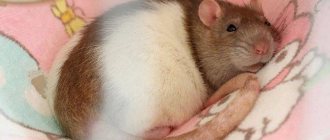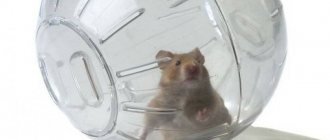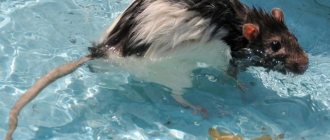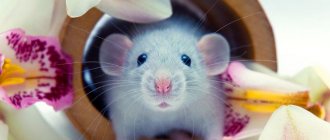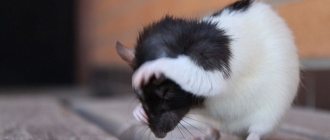New rat in the house
New rats tend to sneeze as they get used to their environment. Their whole environment is different and their noses are busier than usual exploring their new home.
This sneezing should stop after a couple of days once they have adjusted. However, if they were previously kept on poor litter, it may take a little longer. They now expel toxic filler irritants from their system.
As long as there are no other signs of illness, the rat should be fine. But keep an eye on it and any new symptoms that may indicate a respiratory infection.
If the sneezing continues and is the only symptom, look for something specific that they are not adjusting to. It could be something obvious, like the smell of cigarette smoke, or something less obvious, like an odor you tolerate. Then you need to eliminate it completely and see if the sneezing stops.
This may not work and the sneezing may continue. Or if you can't find anything specific that might be the problem, it's a good idea to take your pet to a veterinarian for a check. Then the animal’s condition will be under control. Although it may just be that the rodent needs more time to adapt.
There are times when a new pet may sneeze for two or even three weeks. However, you should be wary of any sneezing that lasts that long. Therefore, if you decide to "wait", be especially vigilant and watch your rat closely for any other signs of illness.
It has also been suggested that some new rats tend to sneeze more frequently when stimulated due to increased histamine levels. If there is a pattern to sneezing, such as the rat will sneeze more often when it leaves its cage, when it is being held, or when it is running around playing, this may be the case. Again, this should subside once they have adjusted to you and their environment.
Birth defects
Sometimes it can be difficult for an owner to figure out why a rat is sneezing. The animal may not show other signs of illness. The cause of sneezing may be an incorrect structure of the nasal septum. This defect is a congenital feature. Due to a deviated septum, the nasal passages cannot clear mucus naturally. And the animal has to periodically sneeze to get rid of nasal secretions.
If the animal feels well, then there is no reason to worry. However, it is important to remember that sneezing associated with defects in the structure of the nose has been observed in rats since childhood. If such a symptom first appears in an adult animal, then it is associated with other reasons.
What to do if it is not a new rat sneezing?
Is sneezing the only symptom and does it come on suddenly? This could be an allergy or a reaction to something in the environment that is irritating the airways.
Have there been any changes in the cell or environment? For example, have you recently dusted or used an air freshener? Have you changed your perfume, laundry detergent, or how you clean your cage? Is the air drier than usual? Are the windows open? Is there pollen? Is there smoke?
If your rat seems otherwise normal and only sneezes occasionally, keep an eye on it and wait a day. If the rat is still sneezing the next day and there is nothing obvious in the environment that has changed, then make an appointment with your veterinarian to be examined in case it is the beginning of a respiratory infection.
Parasite infestation
A rat also sneezes when infected with skin parasites (fleas, lice eaters, ticks). This is accompanied by severe itching. Insect waste products cause a severe allergic reaction.
Fleas and lice eaters can be detected with the naked eye. To do this, you need to carefully examine the pet, parting the fur. As for ticks, this parasite is microscopic in size. It can only be detected with the help of a special analysis in a veterinary clinic.
If infected with parasites, the animal must be washed with pet shampoo. It is also useful to use Frontline or Bars spray.
What is a respiratory disease?
Mycoplasma pulmonis is a bacterium that is naturally present in the respiratory system of rats.
Stress, illness, old age, genetics or other factors can weaken a rat's immune system. This allows mycoplasma bacteria to establish and multiply, resulting in a mycoplasma infection or “mycoplasma outbreak.” This infection, in turn, makes the rat more susceptible to secondary bacterial infection. Once the secondary infection has moved on, the mycoplasma bacteria will become out of control.
The infection may begin in the upper respiratory tract (nasal passages and ears). And if left untreated, it can spread to the lungs.
Lower respiratory tract infections are much more serious. They must be treated quickly or they can be fatal.
Signs that your rat may have a respiratory infection.
Early signs:
- Sneezing.
- Porphyrin around ears and nose.
- Squeaking, sniffling, grunting, humming, chirping, or cooing sounds when breathing.
- If the inner ear is affected, tilting the head, rubbing the face or ear, rolling.
- Hiccups accompanied by chirping, squeaking or whistling sounds.
Late signs:
- Excess porphyrin, sneezing.
- A rattling, watery, bubbling or wheezing sound when breathing.
- Cough.
- Labored breathing.
- The head moves from side to side when breathing.
- Lack of air.
- When holding a rat, a rattling vibration is felt in the chest.
Other signs of illness to look out for:
- Lethargy.
- Dull fur.
- Hunched posture.
- Loss of appetite and weight.
- Changes in behavior due to illness, such as biting or avoidance.
Wool mites
Cheylettiella parasitivorax are microscopic mites that live in the fur of rats. These are blood-sucking parasites that feed by biting your pet, causing it to itch. These parasites are sometimes called "walking dander" because they can be seen moving along the dead skin of rats.
These mites can appear outdoors, as well as from food or bedding that is brought into the house. Signs that your pet has fur mites can include itching and scratching, hair loss, and the presence of itch.
To treat fur mites, take your rat to the vet and he will prescribe a topical gel or oral mite treatment.
Additionally, disinfect all grooming materials and sterilize your pet's environment. Discard all organic materials to prevent re-infestation.
What to do if your rat has a respiratory infection?
Treatment is a course of antibiotics that you will need to get from your veterinarian.
It is extremely important to seek medical attention immediately. Rats can get sick very quickly due to their high metabolic rate. In addition, the first symptoms of respiratory disease observed in rats are often caused by a secondary infection. Secondary infections can become serious more quickly than mycoplasma.
The earlier treatment is started, the better the prognosis for the rat.
Poor nutrition
Sometimes a rat sneezes due to a lack of nutrients in its food. This symptom most often results from a deficiency of vitamin A. In this case, there is a deterioration in the quality of hair and vision, lacrimation, and weight loss. The growth of rat pups slows down.
If you have vitamin A deficiency, you need to include carrots, liver, fish oil, and egg yolk in your animal’s diet. If necessary, you can give your pet vitamins in tablet form. The dosage of drugs should be determined by a veterinarian.
What will the veterinarian do?
Your veterinarian should listen to your rat's chest and lungs with a stethoscope to check for congestion. They must then prescribe antibiotics.
Baytril is a standard antibiotic prescribed for respiratory infections.
Other antibiotics:
- Doxycycline: works well in combination with Baytril in more complex cases;
- Zithromax: can be safely used in young rats;
- Clavamox: Very effective when combined with Baytril.
If symptoms are detected early, you are most likely dealing with an upper respiratory tract infection. If your rat has this infection, the lungs will be clear, but that doesn't mean they don't need treatment.
Please don't let an inexperienced veterinarian send you home without antibiotics. A rat's lungs may be clear, and a bad vet will think she is healthy.
You need to treat your rat now before the infection can spread to the lungs. For this reason, it is important to understand the difference between an upper respiratory tract infection and a lower respiratory tract infection so that you can explain it to your veterinarian if necessary.
Some veterinarians will refer to older textbooks that use lower dosages over a shorter period of time than are currently recommended.
A good course of these antibiotics is at least 14-30 days. If your veterinarian only provides a 7-10 day course, change specialists.
Antibiotics should not be added to drinking water. If your veterinarian prescribed you such antibiotics, then he is a bad specialist!
Veterinarians don't always make the right decisions, and it's okay to ask questions and give them new information. If they are good veterinarians, they will listen to you.
Lice
Parasites are extremely common in rat groups and are fairly easy to eliminate. Ask your veterinarian to give three injections of Ivermectin, 14 days apart, to all rats, not just those showing symptoms.
Lice, in particular, are large enough to be visible as moving dark brown spots on the fur. Most veterinarians charge a fee per visit for all rats. It is recommended that all cage items and bedding be cleaned during treatment, but this is probably not necessary. Then watch to see if the treatment works.
Can the vet prescribe anything other than antibiotics?
Yes, there are several other medications that can help.
Anti-inflammatory drugs reduce inflammation in the lungs, allowing the rat to relax and breathe easier while waiting for the antibiotics to take effect. They may also speed up recovery because penetration of antibiotics is improved. Both steroidal and non-steroidal anti-inflammatory drugs can be used. In particular, Dexamethasone (a steroid) has been found to be particularly effective against inflammation caused by mycoplasmas and may even reduce the number of mycoplasmas.
Bronchodilators widen the airways of the lungs and make breathing easier by relaxing the smooth muscles of the bronchi.
Mucolytic drugs, such as Bisolvon, soften the mucous membranes, making coughing easier. This, in turn, improves the penetration of antibiotics.
Ear mites
Psoroptes cuniculis are ear mites that cause itching and scratching in the ears of their hosts. These parasites spread from rat to rat, so be sure to wash your hands after handling an animal with ear mites.
Signs of ear mites include balding around the ears, crusts around the ears, and the rodent's ears may appear dirty. If your rat tilts its head, flaps its ears, and shakes its head more than usual, this could also be a sign of ear mites.
If you notice these signs in your pet, take him to the vet. They will perform an examination to determine the presence of ear mites and prescribe anti-parasitic medications.
During the treatment period, ensure that the pet's environment is thoroughly cleaned and remove all bedding.
How to relieve a rat's condition at home?
Exposure to steam may help. Take your pet with you to the bathroom, turn on the shower and let them breathe in the steam for 5-15 minutes. You will need to monitor your pet closely. Some will relax and breathe more freely, but others may not like it and become stressed. If your rat shows any signs of additional stress, take him to safety.
Dark chocolate is also often mentioned. However, it is only useful as a bronchodilator if your rat is in respiratory distress and is having difficulty breathing. But it's hard to imagine that a rat, gasping for breath, would decide to stop to eat the chocolate.
Excessive washing
The Rat may groom itself or others excessively. Causes include stress, overcrowding or incompatible social groups.
Excessive washing of the animal will prevent external skin lesions such as scabs and ulcers. Body hair may be broken in just one area or all over the body, but the skin underneath should be intact.
Treatment may include trial separating animals through a mesh partition or reducing overcrowding. If this is not possible, try increasing the available space with additional hanging hammocks or tunnels.
Prevention of respiratory diseases
- Keep the cage clean! Studies have shown that keeping rats in dirty cages dramatically increases the number of mycoplasmas due to the accumulation of ammonia from their urine. It sounds simple, and it is - always keep the cage clean and well ventilated.
- Provide a stress-free environment. Don't put them in a cage that is too small.
- Do not expose them to dust, smoke or drafts.
- Use quality litter. Avoid anything dusty or containing phenols (such as pine and cedar).
- Provide a high-quality (low protein, low fat) diet rich in vitamins. Research shows that vitamins A, C, and E may be especially helpful in fighting respiratory diseases.
- Echinacea strengthens the immune system and is a preventive measure.
- If possible, maintain an optimal room temperature for rats. The recommended temperature range is 18 to 27 degrees Celsius.
- Do not expose them to other rats that may be sick.
- Try to keep the air moist. This is especially important if you have heaters or air conditioners. Humidifiers and vaporizers work well in rat-infested areas. Or you can simply place plants or bowls of water in the room.
Stressful situation
Decorative domestic rats are very sensitive and vulnerable animals that can be frightened or stressed by a huge number of factors. For example, moving to a new place, changing a cage, a loud sound, the absence of an owner, the appearance of new people, the acquisition of new animals, and much more.
If you bought an active, cheerful and cheerful animal, and upon arrival home he began to sneeze, try to create comfortable conditions, install the cage in a quiet place, talk to him in a gentle voice, treat him with a treat so that he quickly adapts and calms down.
If these recommendations do not help, it may be a cold, which usually has other symptoms. There is no need to waste time; you need to see a veterinarian as soon as possible.
My rat is showing symptoms of a respiratory illness, but could it be something else?
Unfortunately yes. If you and your veterinarian have completed all recommended antibiotic treatments and are not seeing the improvement expected, you need to consider other options.
X-rays can reveal the presence of any tumors. Case studies of rats that were thought to have respiratory problems but were then X-rayed revealed tumors in the lungs, thymus and heart.
Another possible cause of sneezing is a heart condition. Congestive heart failure, heart murmurs, and heart disease can cause fluid to accumulate around the lungs.
Avitaminosis
A lack of essential vitamins can cause various ailments and discomfort, including:
- Apathy
- Sneezing
- Itchy skin
- Hair loss
- The occurrence of painful ulcers and other skin lesions
Diet is very important for the quality of life of a rodent; the diet should include balanced food, a sufficient amount of grains, herbs, fruits and vegetables.
In addition to minor troubles, amitosis contributes to a decline in immunity, and as a result, metabolism is disrupted and serious diseases occur.
The veterinarian, having identified a lack of vitamins, will prescribe a treatment regimen, which consists of a course of injections and adjusts the diet. If vitamin deficiency is not at a critical stage, pharmacy vitamin complexes will be enough. Often, such vitamins are produced in granules, with special additives, so that the animal consumes vitamins without problems.
Allergy
All veterinarians who work with rats believe that allergies are a fairly common phenomenon. The culprits may be certain types of litter, disinfectants, cleaning agents, or products.
Allergic reactions to food can also cause skin problems. Rats are not born with these allergies, but they can develop, usually after a period of eating various foods. Common sources of protein, such as animal meats and other sources, may be responsible, although any food can cause problems.
In addition to itching, symptoms may include indigestion. Properly diagnosing an allergy will take time because it is a diagnosis of exclusion. Your veterinarian will usually recommend a special diet limited to a few simple proteins that your pet has probably never eaten.
The pet should eat exclusively on this diet for several months. If this works and the allergy signs disappear, the ingredients can be added back into the diet one at a time until the culprit is identified. This process can take months, and during this time it is important that you do not give any treats or other foods that have not been approved by your veterinarian because even a very small amount of the offending ingredient can cause an allergic reaction.
Contact allergies are another cause of skin inflammation. Problems can arise after the animal comes into contact with certain irritants or allergens. Some of these allergens may come from common items such as blankets, carpets, plastic food containers, furniture padding or bedding. If the offending substance can be identified and removed, treatment can begin. In most cases, your veterinarian can prescribe medications to relieve the condition.
Treatments that may help a rat with allergies would include:
- Shampoo and conditioner for leather.
- Fish oil in the diet (3g per kg per day has been shown to be effective, which equates to almost a whole 1g capsule for a large rat, so it's best to start with a lower dose).
- Prednisolone drops from the vet (this is a bit risky so it's a last resort).
Ringworm
Ringworm is a fungal infection of the skin. In theory this is as common in the rat as it is in the cat or dog, but in practice it appears to be rare. The clue will be skin lesions that appear on a family member in contact with the person.
Your veterinarian may recommend skin rinses or creams if ringworm is suspected. Be careful when using anything medicinal on a rat's surface to avoid absorption or ingestion of excessive and toxic doses.
Causes of increased porphyrin secretion
Increased release of porphyrin is possible for the following reasons:
- bright light;
- decline in the animal's immunity;
- moving to a new home;
- stress;
- pain;
- state of shock;
- sudden change in conditions of detention;
- shortage of drinking water;
- poor quality diet;
- bathing;
- loud noise and vibration;
- animal disease.
Excessive release of porphyrin may indicate infection of the animal with salmonellosis, mycoplasmosis, or diphtheria. In this case, it is necessary to pay attention to the totality of symptoms observed in the animal.


